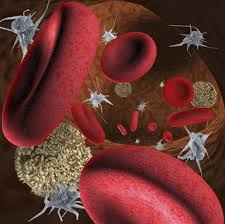Biology

- #45 The Components Of Blood, O2 And Co2 Transport
The body contains approximately 5 litres of blood and this is a mixture made up of red blood cells, white blood cells and platelets all suspended in a liquid called plasma. 1. Blood components Red blood cellsTransport O2 from lungs...
- #43.2 Transport In Mammals - Syllabus 2016
8.1 The circulatory system 8.2 The heart As animals become larger, more complex and more active, transport systems become essential to supply nutrients to, and remove waste from, individual cells. Mammals...
- Myeloid
Term: myeloidLiterally meaning: ?bone marrow (or core) like?Origin: Anc Greek??????/myelos(=bone marow, core)>???/myo(=to be enclosed)-??????/-oides(=-oid, prefix meaning ?like?, ?type?, ?form?) Coined/HistoryIn 1869 by The Neumann, as he was the first...
- Comparison Of Different Types Of Wbcs (white Blood Cells)
Comparison of different types of WBCs (White Blood Cells or Leucocytes) Characteristics Neutrophils (Heterophils) Basophils(Cyanophils) Eosinophils (Acidophils) Monocytes lymphocytes Percentage 62% 0.5-2 % 2-4 % 5.3% 30% Diameter 10-12...
- Body Fluids And Circulation
Click here for PDFCirculation is the transport of nutrients, oxygen, CO2 and excretory products to the concerned tissues or organs.For circulation, simple organisms (sponges, coelenterates etc) use water from their surroundings....
Biology
Comparison between RBC and WBC
| RBC (Red Blood Cells or Erythrocytes) | WBC (White Blood Cells or Leucocytes) |
| 1. Red coloured due to presence of haemoglobin | Colourless |
| 2. Nucleus, Golgi complex, mitochondria etc are absent in mature mammalian RBC | Present. |
| 3. Lifespan is 120 days | Generally short lived (1- 15 days) |
| 4. Function: Transports oxygen from lungs to the tissues and carbon dioxide from tissues to lungs | It acts as the part of immune system and gives defense to our body against pathogens |
| 5. Normal Count is 5 - 5.5 millions/ mm3 | Normal Count is 6000-8000 /mm3 |
| 6. Formed in: Red Bone marrow | Formed in: Red Bone marrow, lymph glands, spleen |
| 7. Single type | Many types such as neutrophil, basophil, eosinophil, monocyte and lymphocyte. |
- #45 The Components Of Blood, O2 And Co2 Transport
The body contains approximately 5 litres of blood and this is a mixture made up of red blood cells, white blood cells and platelets all suspended in a liquid called plasma. 1. Blood components Red blood cellsTransport O2 from lungs...
- #43.2 Transport In Mammals - Syllabus 2016
8.1 The circulatory system 8.2 The heart As animals become larger, more complex and more active, transport systems become essential to supply nutrients to, and remove waste from, individual cells. Mammals...
- Myeloid
Term: myeloidLiterally meaning: ?bone marrow (or core) like?Origin: Anc Greek??????/myelos(=bone marow, core)>???/myo(=to be enclosed)-??????/-oides(=-oid, prefix meaning ?like?, ?type?, ?form?) Coined/HistoryIn 1869 by The Neumann, as he was the first...
- Comparison Of Different Types Of Wbcs (white Blood Cells)
Comparison of different types of WBCs (White Blood Cells or Leucocytes) Characteristics Neutrophils (Heterophils) Basophils(Cyanophils) Eosinophils (Acidophils) Monocytes lymphocytes Percentage 62% 0.5-2 % 2-4 % 5.3% 30% Diameter 10-12...
- Body Fluids And Circulation
Click here for PDFCirculation is the transport of nutrients, oxygen, CO2 and excretory products to the concerned tissues or organs.For circulation, simple organisms (sponges, coelenterates etc) use water from their surroundings....
